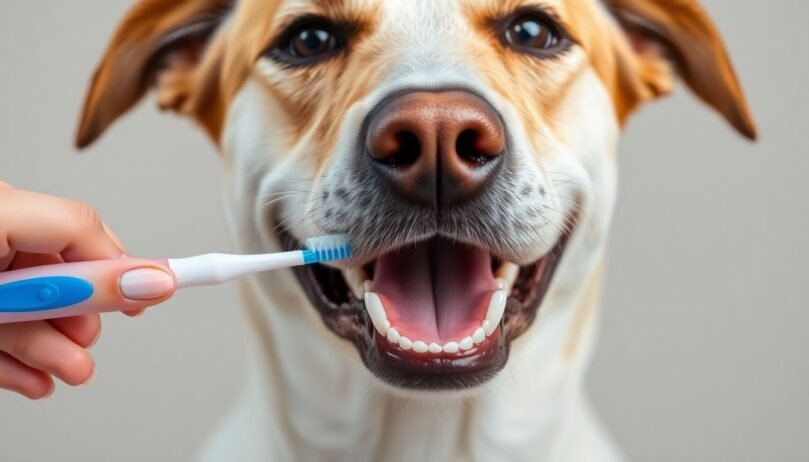How to Keep Your Dog’s Teeth Clean
- 10 December 2024
- BuyAPet Editorial Team
- All Dogs, Dog Health
How to Keep Your Dog’s Teeth Sparkling Clean: The Ultimate Guide
Keeping your dog’s teeth clean isn’t just about fresh breath—it’s about a longer, happier life. Here’s the friendly, vet-informed routine that actually works.
The Importance of Canine Dental Hygiene
The Shocking Stats
Over 80% of dogs show signs of dental disease by age three. Early, consistent care saves your dog discomfort—and you money—later on.
Why It Matters
Oral bacteria can enter the bloodstream and affect the heart, kidneys, and liver. Good dental care supports whole-body health.
Brushing Basics: Mastering the Technique
Pick the right tools
- Toothbrush: Soft-bristled dog brush or finger brush sized for your dog.
- Toothpaste: Dog-specific only (flavors like chicken or peanut butter). Never use human toothpaste.
Step-by-step
- Get comfy: Calm spot, good lighting.
- Introduce: Let your dog lick a pea-sized dab of toothpaste.
- Start slow: Brush a few teeth; build up over days.
- Angle right: Aim at the gumline (where plaque builds).
- Make it fun: Praise during & after. End on a win.
Brush-day checklist
- ✔ Pea-sized dog toothpaste ready
- ✔ 45–60 seconds per side
- ✔ Focus on outer tooth surfaces
- ✔ Treat + praise to finish
Reluctant dog?
Desensitize gradually: touch lips → lift lips → touch teeth → gentle brush. Use high-value treats, keep sessions under a minute, and stop before your dog wants to.
Beyond Brushing: Extra Cleaning Options
Dental chews & treats
Great plaque-reducing helpers—look for vet-approved products with quality ingredients.
Dental wipes
Good when brushes are a no-go; wipe along the gumline to remove debris and reduce plaque.
Water additives
Add to drinking water to cut bacteria and freshen breath. Ensure it’s safe for dogs and follow the label.
Good to know
These are supplements, not replacements. Brushing remains the gold standard.
Recognizing & Addressing Dental Problems
Common signs
- Persistent bad breath
- Red, swollen, or bleeding gums
- Difficulty chewing or dropping food
- Excessive drooling
When to see your vet
If you spot these signs, book an exam. Early treatment prevents pain and bigger problems.
Professional cleanings remove tartar a brush can’t reach—especially under the gumline.
Nutrition’s Role in Dental Health
A balanced diet supports oral health. Kibble textures and certain formulations can help reduce plaque and tartar.
- Choose: High-quality foods designed to support oral hygiene.
- Avoid: Sticky, sugary treats and excess refined carbs.
Smart feeding + regular brushing = fewer vet visits and a happier pup.
Create a Long-Term Dental Care Plan
- Consistency: Brush 2–3×/week (daily if you can).
- Reinforce: Reward after each session to build positive vibes.
- Prevent: Schedule regular veterinary checkups and follow their dental care advice.
FAQs
How often should I brush my dog’s teeth?
Daily is ideal, but 2–3 times per week still delivers big benefits.
My dog hates brushing. What can I do?
Go slow with desensitization, use tasty dog toothpaste, keep sessions under a minute, and reward generously. Try wipes as a bridge to brushing.
Are dental chews enough on their own?
No—chews help but don’t replace brushing. Use them as a supplement.
What are the signs of dental disease?
Bad breath, red or bleeding gums, drooling, pawing at the mouth, or difficulty eating. See your vet if you notice these.
Is human toothpaste safe for dogs?
No. Many human toothpastes contain xylitol and fluoride—both unsafe for dogs. Use dog-specific toothpaste only.
When does my dog need a professional cleaning?
Your vet will advise based on an oral exam. Professional scaling under anesthesia removes tartar under the gumline where brushes can’t reach.
Resources for further learning: your veterinarian is the best source for personalized dental advice tailored to your dog’s breed, age, and health.
